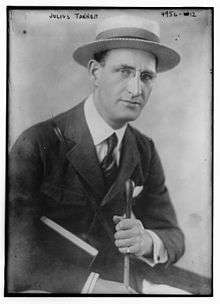Julius Tannen
| Julius Tannen | |
|---|---|
 Tannen in 1919 | |
| Born |
May 16, 1880 Manhattan, New York City, U.S. |
| Died |
January 3, 1965 (aged 84) Woodland Hills, California, U.S. |
| Occupation | vaudevillian, comedian, actor |
| Years active | 1901–1959 |
Julius Tannen (16 May 1880 – 3 January 1965) was a monologist in vaudeville.[1] He was known to stage audiences for his witty improvisations and creative word games. He had a successful career as a character actor in films, appearing in over 50 films in his 25-year film career.[2] He is best known to film audiences from the musical Singin' in the Rain, in which he appears as the man demonstrating a talking picture early in the film.
Biography
Tannen was born on 16 May 1880.[1] He never intended to become a performer. As a young man, he was a salesman whose pitch was so good that he began to get offers to entertain at parties. He made his professional vaudeville debut at the age of 21, and soon developed into a monologist, the predecessor to today's stand up comic. He would frequently end his routines before the payoff of the story, allowing the audience to complete it for themselves, and exited with the phrase "My father thanks you, my mother thanks you, my sister thanks you, and I thank you," which was co-opted by the young George M. Cohan.[3]
Tannen made his Broadway debut in 1905,[4] in a musical comedy called Lifting the Lid[5] and went on to appear in three other productions in the next year. As a vaudevillian, he played the Palace Theatre in New York City – the apex of vaudeville performing – more often that almost any one else,[3] indicating that he was at the peak of his profession. He appeared again on Broadway in 1916, and returned again in 1920, in a comic play with music, Her Family Tree, for which he received credit for writing his own scenes.[6] Tannen was also seen in two editions of Earl Carroll's Vanities, in 1925 and 1926,[4] and in George White's Scandals.[3]
The advent of talking pictures created a need in Hollywood for performers with stage experience, and Tannen appeared in his first film in 1935,[2] when he did an uncredited bit in Stranded.[7] This set him upon his 25-year career as a character man, although his work frequently went without credit.
In the 1940s, Tannen was part of Preston Sturges' unofficial "stock company" of character actors, appearing in eight films written and directed by Sturges, with the size of his roles increasing over time.[8] Undoubtedly, Tannen's most memorable and prominent performance came at the age of 72, when he portrayed a man demonstrating the technology of talking pictures in a film-within-the-film in Singin' in the Rain in 1952.[3]
Tannen continued to appear in films until 1959, when he was seen in an uncredited role in director John Sturges' Last Train from Gun Hill.[9] He continued to work until he suffered a stroke in 1964. He died the following year, at the age of 84, on 3 January 1965 at the Motion Picture Country Home in Woodland Hills, California.[1]
Legacy
Lucille Ball said that seeing Tannen perform in her hometown of Jamestown, New York when she was a child inspired her to go into show business.
His sons, William Tannen and Charles Tannen, were both successful film and television actors; William had a recurring role on The Life and Legend of Wyatt Earp; Charles later became a television executive.
References
- 1 2 3 "Julius Tannen, Vaudeville Star And Film Actor, Is Dead at 84". New York Times. January 5, 1965.
- 1 2 Julius Tannen on IMDb
- 1 2 3 4 Eder, Bruce Biography (Allmovie)
- 1 2 Julius Tannen at the Internet Broadway Database
- ↑ Lifting the Lid on IMDb
- ↑ Her Family Tree at the Internet Broadway Database
- ↑ Stranded on IMDb
- ↑ Tannen appeared in Christmas in July, The Lady Eve, Sullivan's Travels, The Palm Beach Story, The Miracle of Morgan's Creek, Hail the Conquering Hero, The Great Moment, The Sin of Harold Diddlebock and Unfaithfully Yours. Earlier, he had appeared in Remember the Night, which was written by Sturges.
- ↑ Last Train from Gun Hill on IMDb
External links
- Julius Tannen at the Internet Broadway Database

- Julius Tannen on IMDb
- Julius Tannen at the TCM Movie Database

- Julius Tannen at AllMovie